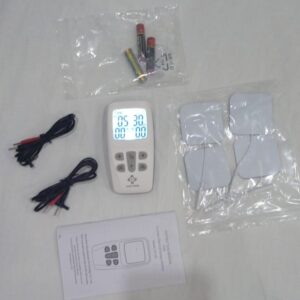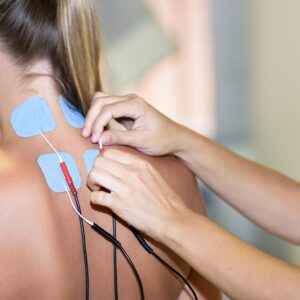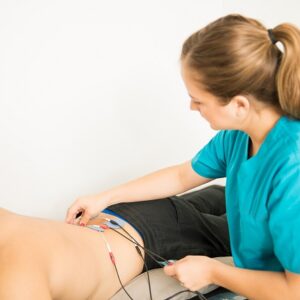TENS Therapy In Physiotherapy is widely used modality, TENS is an abbreviation for Transcutaneous Electrical Nerve Stimulation, a therapy that uses low-voltage electrical currents to relieve pain. TENS involves placing electrodes on the skin that deliver electrical impulses to the underlying nerves. These impulses can help block the transmission of pain signals by hormonal release (endorphins), the body’s natural painkillers.
TENS Therapy In Physiotherapy is simply understand by, “TENS” is a therapy that involves applying electrical currents to the skin to relieve pain. TENS treats chronic pain like back pain, arthritis, fibromyalgia, and acute pain from injuries or surgeries. TENS therapy controls painful conditions like back pain, arthritis, and neuropathy. TENS Therapy In Physiotherapy is considered a safe and non-invasive treatment option compared to other pain management strategies.
Read More: Read More about other Physiotherapy Modalities, Infrared Therapy in Physiotherapy, What is Therapeutic Laser Therapy?, and Therapeutic Ultrasonography.
Table of Contents
Indications of TENS Therapy In Physiotherapy
TENS Therapy In Physiotherapy works by using electrical stimulation to reduce the sensation of pain. The electrical impulses generated by the TENS unit travel through the skin and into the nerves, where they can block pain signals from being transmitted to the brain. Some indications that TENS may be appropriate include:
1. Chronic pain: TENS treat chronic pain problems, such as low back pain, osteoarthritis, and neuropathic pain.
2. Acute pain: TENS can also manage acute pain after surgery or injury.
3. Non-pharmacological pain management: TENS is an alternative to or in conjunction with medication for pain management.
4. Palliative care: TENS can manage pain in patients with terminal illnesses who do not want to or cannot take medication.
5. Physical therapy: TENS can be used as physical therapy to relieve pain and promote healing after injury or surgery.
It’s important to note that TENS Therapy In Physiotherapy may not be appropriate for everyone, and it’s important to talk to a healthcare provider before starting TENS therapy. Keep TENS away from eyes, front of neck, chest and heart.
What is TENS Unit

The TENS machine is a small battery-powered device that sends electrical impulses to nerve endings through electrodes placed on the skin. These electrical impulses can help to alleviate pain and muscle tension. TENS units are often used as a non-invasive and drug-free way to manage chronic or acute pain.TENS machines typically have a small control unit with a digital display and buttons to adjust the settings, such as the intensity and frequency of the electrical impulses.
The unit is connected to electrodes that are placed on the skin in the area where the pain is experienced. The machine sends electrical impulses to the nerve endings, which can reduce pain perception.
TENS units come in different sizes and shapes and can be used on other body parts. They are typically small and portable, making them easy to use at home, work, or while travelling
Electrode Placement of TENS Therapy in Physiotherapy

The placement of electrodes for TENS (Transcutaneous Electrical Nerve Stimulation) therapy will depend on the location and type of pain. However, there are some instructions for electrode placement:
1. Identify the area of pain: Determine where and what type of pain it is (e.g., chronic, acute, neuropathic).
2. Clean and dry the skin: Before placing electrodes, ensure that the skin is clean and dry to optimize the conductivity of the electrical current.
3. Choose the electrode size and shape: Select the appropriate size and shape of the electrode based on the area of pain and the individual’s comfort level.
4. Place electrodes on or near the area of pain: Place electrodes directly over the area for localized pain. For diffuse pain, place electrodes on or near the nerve pathways leading to the pain’s size.
5. Experiment with electrode placement: If the initial electrode placement does not provide adequate pain relief, try repositioning the electrodes in different locations to find the optimal arrangement.
Following the TENS unit’s instructions and seeking guidance from a healthcare provider if unsure about electrode placement or TENS therapy is essential. Improper electrode placement or use can lead to discomfort or adverse effects.
Mechanism of TENS Therapy In Physiotherapy

The specific mechanism by which TENS Therapy In Physiotherapy reduces pain is not fully understood; there are the following proposed mechanisms:
1. Gate Control Theory: This theory suggests that the electrical impulses delivered by the TENS unit activate the large-diameter nerve fibres that transmit non-painful sensations, which can “close the gate” on the smaller-diameter nerve fibres that transmit painful feelings. This can reduce the overall success of pain.
2. Endorphin Release: TENS stimulates the release of hormones (endorphins); endorphins can reduce pain by binding to opiate receptors in the brain and spinal cord.
3. Central Nervous System Effects: TENS may also affect the central nervous system, including changes in brain activity and neurotransmitter release in pain signalling.
TENS therapy is customized to meet the individual needs of the user, including the frequency, intensity, and duration of the electrical impulses. It is considered a safe and non-invasive treatment option for pain management.
Types of TENS
Several electrical currents work in TENS (Transcutaneous Electrical Nerve Stimulation) therapy. The most common types of currents used in TENS Therapy In Physiotherapy are:
1. Conventional TENS: High frequency and low intensity current is used in the conventional TENS that stimulates nerves to block pain. This type of TENS is for acute pain.
2. Burst TENS: Burst TENS uses a series of short bursts of electrical current followed by extended periods of no stimulation. This type of TENS is for chronic pain.
3. Modulated TENS: Modulated TENS uses a constantly changing electrical current that varies in frequency, intensity, and pulse duration. This type of TENS is for both acute and chronic pain.
4. Brief-Intense TENS: Brief-Intense TENS uses a high-frequency, high-intensity electrical current delivered for short periods (usually less than 5 seconds). This type of TENS is for acute pain.
5. Acupuncture-like TENS: Low frequency and high intensity current is used in this type of tense, that is similar like acupuncture. This type of TENS is for chronic pain.
The therapist must adjust the intensity of TENS Therapy In Physiotherapy according to the individual’s tolerance level and response to treatment. Start with low power and gradually increase as needed. Following the manufacturer’s instructions or consulting a healthcare professional to use TENS therapy properly is essential.
Contra-indications of TENS Therapy in Physiotherapy
TENS is considered a safe and non-invasive therapy for pain relief. However, there are some contraindications before using TENS Therapy In Physiotherapy:
1. Cardiac pacemakers or defibrillators: TENS therapy may interfere with the functioning of cardiac pacemakers or defibrillators, so it is not for individuals with these devices.
2. Epilepsy: TENS therapy may trigger seizures in individuals with epilepsy or a history of seizures.
3. Pregnancy: TENS therapy is generally considered safe during pregnancy but should not be used on the abdomen or lower back during the first trimester.
4. Malignant tumours: TENS therapy should not be used over or near malignant tumours, as it may stimulate growth.
5. Open wounds or skin lesions: Don’t do TENS therapy on open wounds or skin lesions, as it may interfere with healing.
6. Sensory impairment: Individuals with impaired sensation, such as neuropathy, should be cautious when using TENS therapy, as they may not be able to feel any adverse effects.
7. Allergy to electrode pads: Some individuals may have an allergic reaction to the electrodes used with TENS therapy, so it is essential to check for any allergic reactions before using the treatment.
Always consult a healthcare professional before TENS therapy, especially if you have any underlying disease or concerns.
Literature Review-TENS Therapy In Physiotherapy
Various forms of literature discuss TENS Therapy In Physiotherapy, units of measurement used to describe the intensity of electrical stimulation. Some examples of literature about tens include:
1. Research papers: There are numerous research papers available that discuss tens, including the history of its development, the different types of tens units, and the impact of tens on various conditions such as pain for longer time, fibromyalgia, and postoperative pain. These papers often include data and statistical analysis and recommendations for using tens in clinical settings.
2. Review articles: Review articles provide a comprehensive overview of the current knowledge on a particular topic, in this case, tens. These articles often summarize the results of multiple studies and provide recommendations for future research or clinical practice. Review articles may also highlight controversy or disagreement in the field of tens.
3. Textbooks: Textbooks on physical therapy, pain management, and related fields often include chapters on tens. These chapters may discuss the underlying principles of tens, how it works, and their various applications. Textbooks may also include case studies or practical examples of using tens in clinical settings.
4. Online resources: There are numerous online resources available that discuss tens, including patient education materials, clinical practice guidelines, and professional organizations. These resources may provide information on using tens, its benefits and risks, and how to find a qualified healthcare provider who can administer the therapy.
Overall, literature on TENS Therapy In Physiotherapy is available from various sources, including research papers, review articles, textbooks, and online resources. This literature can provide a comprehensive understanding of tens and its multiple applications in clinical settings.
Summary-TENS Therapy In Physiotherapy
TENS (Transcutaneous Electrical Nerve Stimulation) is a therapy with a low current to manage pain. TENS Therapy In Physiotherapy treat various types of pain, including acute and chronic pain, back pain, neck pain, joint pain, and muscle pain. It is a non-invasive, drug-free therapy that is generally safe and well-tolerated. TENS sends electrical impulses through electrodes placed on the skin near the source of pain. These electrical impulses help block pain and release painkiller hormones to stop the pain.
However, it’s important to note that TENS is inappropriate for everyone. People with heart pacemakers should not use TENS, as the electrical currents can interfere with these devices. Additionally, Dont apply TENS on areas of the skin that are irritated or damaged, and it is not for undiagnosed pain. If considering TENS for pain relief, you must first talk to your doctor or a qualified healthcare professional. They can help you determine if TENS is a safe and effective treatment option for your specific condition and provide guidance on adequately using it.

9 Responses